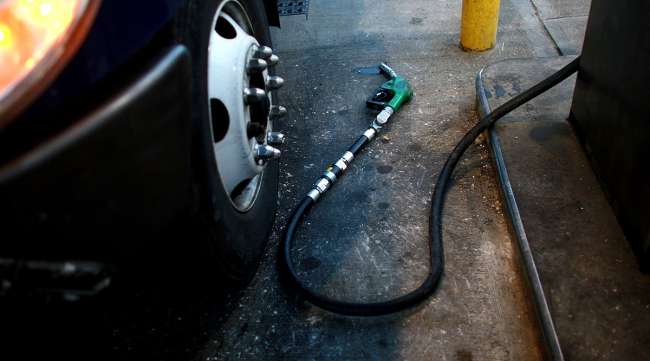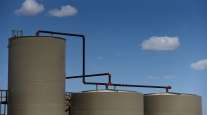Senior Reporter
Diesel Prices Continue to Slide Even as Oil Inches Up

[Stay on top of transportation news: Get TTNews in your inbox.]
The average U.S. retail price of diesel dropped eight-tenths of a cent last week to $2.386 a gallon from $2.394 the week before, the Energy Information Administration reported May 18.
The price of trucking’s primary fuel is now 77.7 cents a gallon less than it was a year ago.
Steve Rush, CEO of Wharton, N.J.-based Carbon Express, which hauls bulk liquid chemicals products, told TT the lower cost of fuel is helping his tank truck company at a time when business is down at least 50%.
“The lower prices right now, yes, it’s helping us, it’s not hurting us, as long as we get a fuel surcharge it should be fine,” Rush said. “But we don’t want fuel to be a profit center for us. We want the fuel to be exactly what it is, or as close to what it is.”

A Carbon Express truck parked in front of a hotel. (Carbon Express)
Rush said that business practice has worked, and even in the pandemic with the price of diesel falling, he has no plans to change his strategy.
“So when we want to raise the price we can go to our customers and say ‘look we are charging you the fuel the way it should be’ and we can show you our fuel costs are and how they relate to the surcharge we are charging you. We don’t want to make money off fuel; it’s too volatile.”
Diesel dropped in all 10 regions the EIA surveys. The least expensive diesel is in the Gulf Coast region, where prices declined by three-tenths of a cent to $2.175 a gallon, which is 73.2 cents cheaper than it was a year ago. The most expensive diesel continues to be in California, which is also the only region in the survey where diesel is more than $3 a gallon. Still, diesel in California fell 1.1 cents a gallon at $3.171 a gallon, putting it 97.4 cents less expensive than it was a year ago.
The West Coast, not including California, saw the steepest decline in diesel prices, falling 1.4 cents to $2.543 a gallon. In that region, the cost of diesel is 80.9 cents a gallon less expensive than it was a year ago.
Meanwhile, the national average price of gasoline continued going in the other direction, rising 2.7 cents per gallon to $1.878. That’s still 97.4 cents per gallon cheaper than a year ago.
Oil jumped 10.4% on May 18 to $32.74 a barrel for the benchmark West Texas Intermediate crude oil. The cost of crude is less than half of its 52-week high of $65.65 a barrel.

COVID-19 has been a wakeup call to many businesses. Knowing the location and status of freight makes all the difference in navigating uncertainty. Host Seth Clevenger speaks with supply chain visibility experts Glenn Koepke and Francis Roy. Hear a snippet, above, and get the full program by going to RoadSigns.TTNews.com.
Oil industry analyst Phil Flynn told Transport Topics the rally was sparked by optimism that more crude will be used as many states are beginning the process of allowing businesses — shuttered at the outbreak of the coronavirus pandemic to reduce its spread — to reopen and restart their economies.
“We already see gasoline demand starting to come back pretty quickly,” Flynn said. “Plus, we’ve seen a drop in U.S. rig counts. U.S. oil production is going to fall pretty dramatically with the rig counts being at the lowest in history.”
According to the Baker-Hughes Co.’s rig count, oil and natural gas exploration has plummeted as the number of active rigs dropped 65.7% in one year from 989 rigs a year ago to 339 on May 12. That’s the lowest number of rigs in operation since Baker-Hughes began keeping records in 1987. Baker-Hughes said its active rig count acts as a leading indicator of demand for products used in drilling, completing, producing and processing hydrocarbons.
Flynn said the deep cut in drilling means the oil market is starting to stabilize, and some of the glut of petroleum is slowly easing.
“Basically, you are seeing a market that was not as tight as it was just a few days ago,” he said.
EIA reports that U.S. domestic oil production the week of May 15 fell 5.7% to 11.5 million barrels per day from 12.2 million the same week a year ago. In that same period, refined distillate fuel production, which includes diesel, fell 3.1% year-over-year to 3.66 million barrels a day from 3.78 million barrels last year.
Flynn expects U.S. oil production to remain slow until there is evidence the market has stabilized and the economy begins to turnaround.
Want more news? Listen to today's daily briefing:




